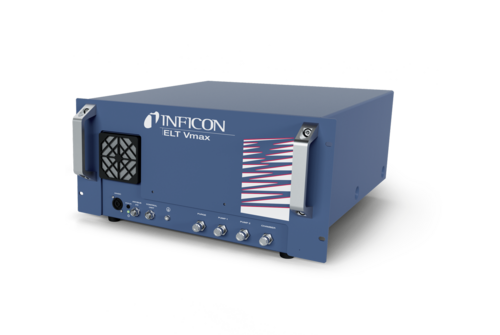Reduced to the Maximum: ELT Vmax
Next generation electrolyte leak detector for system integration


Building on the success of the ELT3000 PLUS, we introduce the ELT Vmax electrolyte leak detector, a specialized device designed for integration into leak testing systems for industrial mass production of battery cells. The ELT Vmax, developed for installation in 19-inch racks, ensures leak tightness of all battery cells filled with liquid electrolyte, including lithium-ion or sodium-ion cells, as well as various cell formats such as prismatic, cylindrical, button cells with rigid casings, or pouch cells with flexible packaging. Like the ELT3000 PLUS, the device uses the patented "Direct Electrolyte Leak Detection" method from INFICON to detect electrolyte leakage from filled cells within a vacuum chamber.
Emphasizing flexibility and integration for maximum testing speed
During development of the ELT Vmax, the focus was placed in particular on maximum flexibility and easy integration into custom-designed testing systems. The detector is intended for use in automatic, leak testing stations for mass production. Unlike the standalone ELT3000 PLUS, which can also be used for leak testing prototypes during development, the ELT Vmax is specifically tailored for high-volume manufacturing environments. Notably, the ELT Vmax has been streamlined. It does not include integrated vacuum pumps, but relies on the use of powerful external pumps for rapid industrial quality assurance. In addition, the ELT Vmax maintains precision and sensitivity, detecting minute leaks down to single-digit micrometer diameters, equivalent to a helium leak rate of 5∙10-7 mbar∙l/s.


Enhanced connectivity and gas carrier flow
Featuring a 19-inch housing and both serial and real fieldbus interfaces, the ELT Vmax allows for straightforward integration into various testing setups. Additionally, it can be equipped with a separate control panel with display if required. The ELT Vmax is approved for use in dry rooms, and its rapid detection of large leaks ensures that escaping electrolyte does not heavily contaminate the testing environment, allowing the system to quickly resume operation for subsequent tests. Furthermore, the carrier gas mode enhances flexibility by enabling variable adjustment of the gas carrier flow rate, significantly improving response time.


Automated calibration for process reliability
For continuous operation in industrial mass production, regular verification of the testing system's functionality is essential. INFICON offers a calibration leak called E-Check 2.0 and a connection kit for fixed integration into the vacuum system for fully automated calibration.


Integrated into the vacuum chamber, the E-Check 2.0 leak is constantly ready for operation, allowing for automatic test measurements at preset intervals. A complete calibration with E-Check 2.0 takes less than 30 seconds, while a simple test measurement to verify test accuracy can be performed within the typical testing cycle time, typically around 12 seconds.
Increasing throughput with multichamber operation and batch testing
ELT Vmax supports multi-chamber operation in test stations with several vacuum test chambers, eliminating waiting times for evacuation and venting processes. In addition, batch testing optimizes the quality assurance throughput in industrial production quality assurance. Battery cells are tested in batches, for example 16, 32 or 64 units. If a batch fails, automatic repeat tests are carried out by halving the batch size until the defective cell is identified. Determining the optimal batch size depends on the typical failure rate in production to effectively maximize throughput
To learn more about our unique ELT Vmax electrolyte leak detector, visit our product page and download the product brochure. You can also watch our on-demand webinar!

